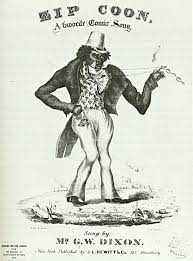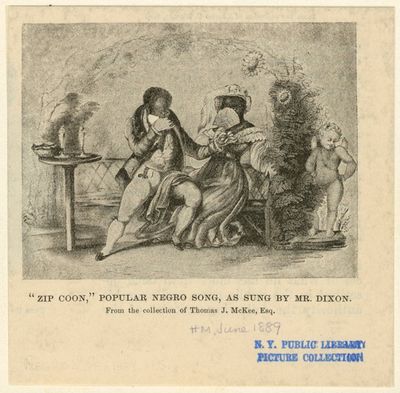Annotation:Old Zip Coon: Difference between revisions
m (Text replacement - "Century Gothic" to "sans-serif") |
No edit summary Tags: mobile edit mobile web edit |
||
| Line 8: | Line 8: | ||
<div style="page-break-before:always"></div> | <div style="page-break-before:always"></div> | ||
<p><font face="sans-serif" size="2"> | <p><font face="sans-serif" size="2"> | ||
<div style="text-align: justify | <div style="text-align: justify;"> | ||
<br> | <br> | ||
[[File:zipcoon.png|300px|thumb|left|]] | [[File:zipcoon.png|300px|thumb|left|]] | ||
Revision as of 20:06, 10 December 2019
X:1 T:Old Zip Coon M:2/4 L:1/8 S:Howe - Complete Preceptor for the Accordeon (1843) Z:AK/Fiddler's Companion K:C (e/d/) | c/B/c/d/ c (E/F/) | G/A/G/E/ G c/d/ | ee e/d/c/d/ | (edd) e/d/ | c/B/c/d/ c (E/F/) | G/A/G/E/ G (c/d/) | e/d/e/f/ g/e/c/e/ | ecc :| (c/d/) | e/f/g/a/ g (g/f/) | e/f/g/a/ g (g/e/) | faa (a/g/) | faa (a/g/) | c'c'/a/ a/g/e/g/ | e/f/e/c/ d (c/d/) | ee/c/ d/c/A/c/ | Gcc ||


OLD ZIP COON. AKA and see "Turkey in the Straw," "Natchez Under the Hill (1)," "Old Bog Hole (The)." American; Minstrel Tune, Breakdown, Reel. USA, Widely Known. G Major: A Major (White): D Major (Phillips): C Major (Howe). Standard tuning (fiddle). One part: AAB (Howe): AABB (Phillips, White). The title of this popular tune is derived from lyric of a widespread and extremely popular minstrel song of the early 1800's. In the early history of blackface minstrels, Colonel T. Allston Brown stated "the tune of 'Zip Coon' was taken from a rough jig dance called 'Natchez Under the Hill,' [named for a saloon town on the river below Natchez, Mississippi] where the boatmen, river pirates, gamblers and courtesans congregated for the enjoyment of a regular hoe-down, in the old time." Mark Wilson says that "Old Zip Coon" was mentioned in chronicles before 1830, and indeed, it appeared in five publications credited to different composers before 1834 (Bronner, 1987) {The titles "Natchez Under the Hill" and "Old Zip Coon" for the melody seem to have appeared almost simultaneously, for the former appears in George P. Knauff's 1839 Virginia Reels, volume I, while the latter appeared in 1834}. The melody is variously thought to have derived from the ballad tune "My Grandmother Lived on Yonder Little Green," according to Linscott (1939), while Bayard (1981) sees the tune as a composite of two Scottish tunes, "Rose Tree (The) (or "Maureen Ni Cullenaun") and "Bonnie Black Eagle (The)"—the first and second strains respectively of "Old Zip Coon." Jabbour concurs, at least with "The Rose Tree" being the origin of this family of American tunes. Mark Wilson is not sure of this connection, however, arguing it is not the similarity of notes but rather "tune personality" that represents a better etiology, and by this criteria he is doubtful "Rose Tree" was an ancestor as its character in traditional performance is so different (see liner notes to Rounder 0529). The "Turkey in the Straw" title for the melody does not seem to have surfaced before the 1880's.
The term 'coon' nowadays has racist associations, but it does not appear that such was implied at the time the tune (and title) was composed. Lexicographer Stewart Flexner (1976) says: "Coon was originally a short form for raccoon in 1741... then by 1832 meant a frontier rustic, and by 1840 a Whig. The 1834 song "Zip Coon" (better known today as "Turkey in the Straw") didn't refer specifically to either a White or a Black and the "coon songs" of the 1840s and '50s were Whig political songs. By 1862, however, coon had come to mean a Black and this use [became] very common [during the 1890s]." Despite this statement, the sheet music of 1834 clearly depicts a comic dandified African-American character. Mark Wilson finds "Old Zip Coon" was popularized on the minstrel stage by Bob Farrell and G.W. Dixon in the early 1830's. A playbill of the Cincinnati Circus, dated April 23, 1841, mentions that "Mr. Brower, the celebrated negro Dancer and Singer will sing and dance 'Jim Along Josey'" and the "Negro Extravaganza-Zip Coon" (Hans Nathan, Dan Emmett and Negro Minstrelsy, 1962, p. 111). 'Mr. Brower' was a black-face performer named Frank Brower (1823–1874), who was soon to team with Dan Emmett to form the first and one of the most famous minstrel troupes, the Virginia Minstrels, and who introduced 'bone playing' before an audience.
There is a contra dance of the same name from New England which Linscott and Burchenal both print. The tune was in the repertoire of Maine fiddler Mellie Dunham. The elderly Dunham was Henry Ford's champion fiddler in the late 1920's. It was recorded by Ozark (Arkansas) fiddler Lon Jordon. In the repertoire of Tennessee fiddler Uncle Jimmy Thompson (1848–1931), one of the first old-time musicians to broadcast over WSM in Nashville, and Opry star Fiddlin' Arthur Smith played a modernized version in the 1930's he called "Straw Breakdown." It was a tune in the repertoire of fiddler and Confederate veteran Arnold A. Parrish (Willow Springs, Wake County, N.C.), as recorded by the old Raleigh News and Observer. Parrish was a contestant at fiddler's conventions held in Raleigh prior to World War I.
Lyrics published in 1834 begin:
O ole Zip Coon he is a larned skoler,
O ole Zip Coon he is a larned skoler,
O ole Zip Coon he is a larned skoler,
Sings posum up a gum tree an coony in a holler,
possum up a gum tree, coony on a stump,
possum up a gum tree, coony on a stump,
possum up a gum tree, coony on a stump,
Den over dubble trubble, Zip Coon will jump.
O zip a duden duden duden zip a duden day.
O Zip a duden duden duden zip a duden day.
O Zip a duden duden duden zip a duden day.
Zip a duden duden duden zip a duden day.
